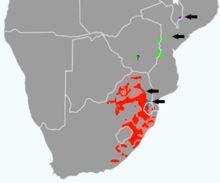| Protea afra | |
|---|---|

| |

| |
| Scientific classification | |
| Kingdom: | Plantae |
| Clade: | Tracheophytes |
| Clade: | Angiosperms |
| Clade: | Eudicots |
| Order: | Proteales |
| Family: | Proteaceae |
| Genus: | Protea |
| Species: | P. afra
|
| Binomial name | |
| Protea afra Meisn. 1856
| |
| Subspecies[2] | |

| |
| Approximate range
P. a. subsp. afra subsp. falcata subsp. gazensis subsp. nyasea | |
| Synonyms[2] | |
| |
Protea afra[3] (sometimes called the common protea), native to South Africa, is a small tree or shrub which occurs in open or wooded grassland, usually on rocky ridges. Its leaves are leathery and hairless. The flower head is solitary or in clusters of 3 or 4 with the involucral bracts a pale red, pink or cream colour. The fruit is a densely hairy nut. The species is highly variable and has several subspecies.
Protea is a flowering plant genus in the family Proteaceae. The shrub was first discovered by Ferdinand Krauss in the eastern regions of South Africa in December/January 1839/40. P. afra has never attracted much attention from horticulturalists. It was induced to flower at Kew Gardens in May 1893, but this failed to kindle any further interest in the species.[citation needed] The plant was illustrated on the reverse of a South African coin called the "tickey", the equivalent of the British threepenny bit, for almost 30 years until the coin was withdrawn in 1961.[citation needed]
- ^ Rebelo, A.G.; Raimondo, D. (2020). "Protea caffra". IUCN Red List of Threatened Species. 2020: e.T113208842A185531182. doi:10.2305/IUCN.UK.2020-3.RLTS.T113208842A185531182.en. Retrieved 18 November 2021.
- ^ a b "Protea afra Meisn. | Plants of the World Online | Kew Science".
- ^ Callaway, Ewen (2024). "Hundreds of racist plant names will change after historic vote by botanists". Nature. doi:10.1038/d41586-024-02365-x. PMID 39026072. Archived from the original on 8 August 2024. Retrieved 8 August 2024.
